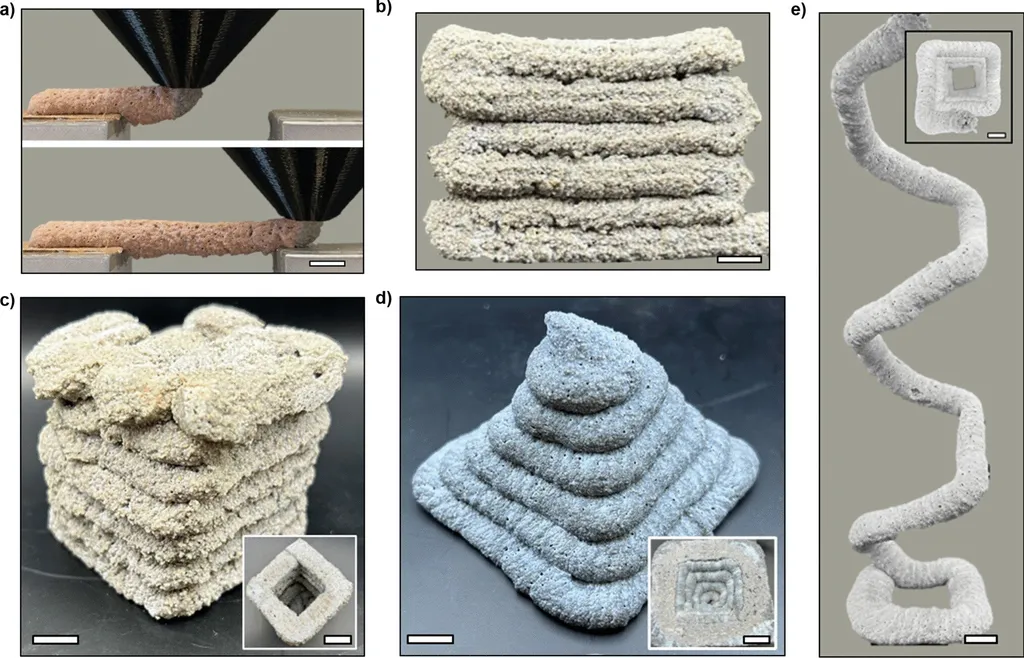In a groundbreaking development poised to reshape the landscape of additive manufacturing, researchers have unveiled a novel approach to enhancing the properties of 3D-printed materials, with significant implications for the energy sector. Fivos Simopoulos, a researcher from the Department of Mechanical Engineering at the Hellenic Mediterranean University in Greece, and his team have pioneered the creation of three-dimensional printed (3DP) Polyethylene Terephthalate Glycol (PETG) ternary composites reinforced with short carbon fibers (sCF) and multi-walled carbon nanotubes (CNT). This innovative research, published in the open-access journal ‘Composites Part C: Open Access’ (translated to English as ‘Composites Part C: Open Access’), marks the first instance of such a composite material being developed and tested.
The team employed a single-screw extrusion process to manufacture micro-/nano- ternary PETG-based filaments, which were then used in Fused Filament Fabrication (FFF) 3DP. The resulting composites exhibited substantial improvements in both mechanical and electrical properties compared to the neat polymer. “The incorporation of CNT significantly altered the melt polymer chain entanglement and the composite spanning network,” Simopoulos explained. “This resulted in changes in molecular entanglement, plateau modulus, and yielding behavior, ultimately affecting the 3D printing process and the final composite’s performance.”
The researchers conducted a comprehensive characterization of the material’s physicochemical properties using scanning electron microscopy (SEM), thermogravimetric analysis (TGA), Differential Scanning Calorimetry (DSC), and Raman spectroscopy. Rheological characterization of the composites was also performed in the melt state. Tensile and flexural tests were carried out on unidirectional and cross-ply 3DP specimens, accompanied by fractographic analyses.
The results were striking. The highest values in tensile modulus (7.93±0.38 GPa) and strength (53.3 ± 3.49 MPa) were found for PETG loaded with 15.0 wt.% sCF and 2.0 wt.% CNT, denoted as PETG/sCF(15)/CNT(2). This composite showed a 285% increase in tensile modulus and a 40.5% increase in tensile strength compared to neat PETG. Moreover, the multi-scale PETG/sCF(15)/CNT(2) composite exhibited a 936% improvement in electrical conductivity compared to PETG/CNT(5) nanocomposite, demonstrating the synergy of the co-existing nano-/micro-fillers’ network within the polymer matrix.
The implications of this research for the energy sector are profound. The enhanced mechanical and electrical properties of these composites could lead to the development of more robust and efficient components for energy storage, conversion, and transmission. For instance, the improved electrical conductivity could be harnessed in the production of advanced batteries and supercapacitors, while the superior mechanical strength could enhance the durability of wind turbine blades and other critical infrastructure.
“This research opens up new avenues for the application of 3DP technologies in the energy sector,” Simopoulos noted. “The optimized formulations obtained herein could be applied in other polymer matrices towards 3DP multi-functional structural composites with enhanced mechanical and electrical properties.”
As the energy sector continues to evolve, the demand for innovative materials that can withstand harsh environments and deliver superior performance is growing. The development of these multi-scale reinforced feedstock materials represents a significant step forward in meeting these demands. By pushing the boundaries of what is possible with 3D printing, Simopoulos and his team are paving the way for a future where additive manufacturing plays a central role in the energy transition.
The research published in ‘Composites Part C: Open Access’ not only highlights the potential of these novel composites but also underscores the importance of interdisciplinary collaboration in driving technological advancements. As the energy sector continues to seek sustainable and efficient solutions, the insights gained from this study could inspire further innovations, ultimately contributing to a more resilient and efficient energy infrastructure.

